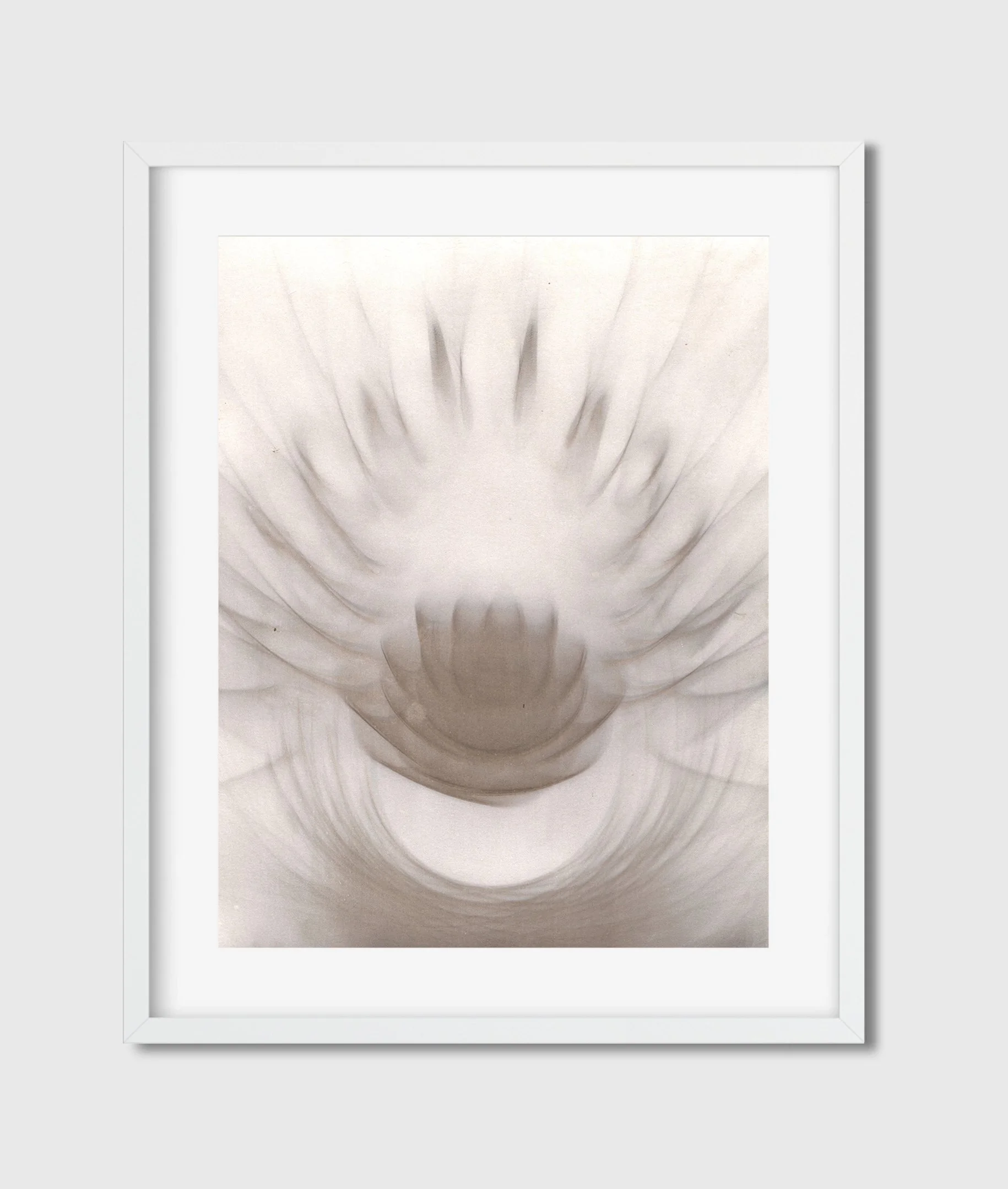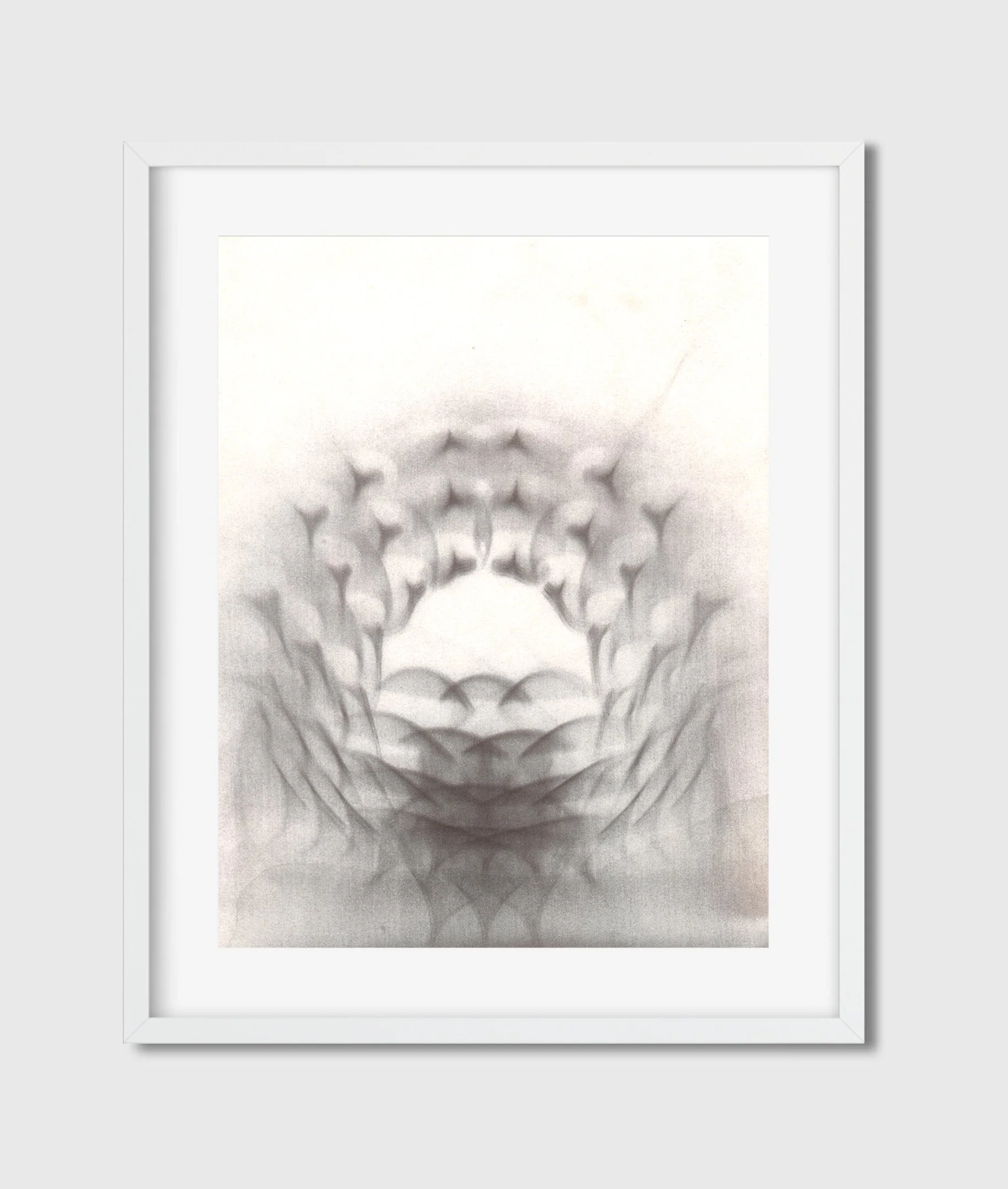蚀
Eclipse
时间:2024夏天
媒介:范戴克古典印相
Date: 2024 Summer
Medium: Van Dyck Prints
《蚀》是一件通过范戴克古典印相形成的作品,范戴克印相(Van Dyke process)是一种古老的摄影技术,主要用于制作银版照片。这种方法通常涉及将感光材料涂在纸或其他表面上,然后通过紫外线曝光。其特点是可以产生丰富的棕色和黑色调,效果柔和且具有复古感。作品通过设计光线装置,光线在透镜和镜子中的反射和折射会遵循特定的几何规律,进而改变紫外线在空间中的密度,使得感光材料在纸面不同区域呈现出不同程度的化学反应,进而将此刻的光线密度映照于纸上。摄影不再是针对物的记录,而成为了针对空的记录,记录着此时此地光的密度与痕迹。
《Eclipse》 is a work formed through the Van Dyke classic printing process. The Van Dyke process is an ancient photographic technique primarily used for creating silver plate photographs. This method typically involves applying a light-sensitive material to paper or other surfaces and then exposing it to ultraviolet light. It is characterized by its ability to produce rich brown and black tones, resulting in a soft, vintage effect. The work utilizes a light installation designed so that the reflection and refraction of light through lenses and mirrors follow specific geometric laws, thereby altering the density of ultraviolet light in space. This causes the light-sensitive material to undergo varying degrees of chemical reaction in different areas of the paper, reflecting the moment's light density onto the surface. Photography thus transcends mere documentation of objects, evolving into a record of emptiness, capturing the density and traces of light in that specific time and place.
《蚀》 是一件探索光与暗之间微妙关系的艺术作品,通过古老的范戴克印相技术实现。这种技术源于银版摄影的传统,采用涂覆在纸上的感光材料,随后进行紫外线曝光。最终产生的丰富棕色和黑色调唤起了一种怀旧感,使摄影的行为从单纯的物体记录转变为与光的本质的深刻互动。
在这个装置中,光通过精心设计的透镜和反射面进行操控,遵循特定的几何原理,改变空间中紫外线的密度。这种互动导致纸面上不同程度的化学反应,捕捉到光在这一刻的短暂本质。因此,作品不仅反映了可触及的事物,也记录了无形的东西—捕捉光在特定时空中的密度和痕迹。
作品标题《蚀》呼应了一种天文现象,其中一个天体遮挡另一个天体,造成暂时的遮蔽。这种遮蔽行为象征着时间的流逝和不可逆转的变化。在此体验中,观众被邀请感受光的温暖与阴影的冷峻交织,促使对生命中瞬间与永恒之间的对立进行反思。
《蚀》挑战了传统的光与暗的认知,鼓励对存在本身的脆弱与美好进行深思。这是一次探索经验中意义层次的邀请,促使我们面对存在与缺席之间的微妙平衡。
《Eclipse》 is an artistic exploration of the delicate interplay between light and darkness, realized through the ancient Van Dyke printing process. This technique, rooted in the tradition of silver plate photography, employs a light-sensitive material coated on paper, which is then exposed to ultraviolet light. The resulting rich browns and blacks evoke a sense of nostalgia, transforming the act of photography from a mere documentation of objects into a profound engagement with the essence of light itself.
In this installation, light is manipulated through carefully designed lenses and reflective surfaces, following specific geometric principles to alter the density of ultraviolet light in space. This interaction leads to varying degrees of chemical reactions on the paper, capturing the ephemeral nature of light in that moment. Thus, the work reflects not only the tangible but also the intangible—recording the density and traces of light as they resonate within a specific time and space.
The title, Eclipse, draws parallels to an astronomical phenomenon where one celestial body obscures another, creating a temporary veil. This act of concealment serves as a metaphor for the passage of time and irreversible change. Through this experience, viewers are invited to sense the warmth of light intertwined with the coolness of shadow, prompting reflections on the fleeting moments of life juxtaposed against the eternal.
Eclipse challenges conventional perceptions of light and darkness, encouraging contemplation of the fragility and beauty inherent in existence. It is an invitation to explore the layers of meaning within our experiences, urging us to confront the delicate balance of presence and absence.









